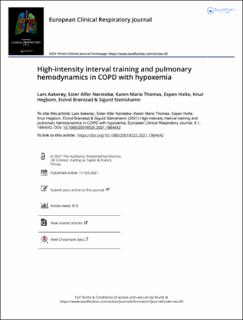| dc.contributor.author | Aakerøy, Lars | |
| dc.contributor.author | Nørstebø, Ester Alfer | |
| dc.contributor.author | Thomas, Karen Marie | |
| dc.contributor.author | Holte, Espen | |
| dc.contributor.author | Hegbom, Knut | |
| dc.contributor.author | Brønstad, Eivind | |
| dc.contributor.author | Steinshamn, Sigurd Loe | |
| dc.date.accessioned | 2022-04-07T09:36:55Z | |
| dc.date.available | 2022-04-07T09:36:55Z | |
| dc.date.created | 2021-10-22T13:42:28Z | |
| dc.date.issued | 2021 | |
| dc.identifier.citation | European Clinical Respiratory Journal. 2021, 8 (1), . | en_US |
| dc.identifier.issn | 2001-8525 | |
| dc.identifier.uri | https://hdl.handle.net/11250/2990455 | |
| dc.description.abstract | Background Exercise is recommended for all patients with COPD. Evidence for its benefit is considerably weaker in the more severe stages of the disease. The aim of this study was to investigate whether high-intensity interval training could improve exercise capacity, pulmonary hemodynamics and cardiac function in patients with severe COPD and hypoxemia. Methods Stable patients with COPD GOLD stage III or IV and hypoxemia were included. They underwent extensive cardiopulmonary testing including right heart catheterization, lung function tests, echocardiography and 6-minute walk test before and after completion of 10 weeks of high-intensity interval training performed with supplemental oxygen. Primary endpoint was change in pulmonary artery pressure measured by right heart catheterization. Results Ten patients with very severe airflow obstruction, mean FEV1 28.7% predicted and mean FEV1/VC 0.39 completed the exercise programme. Pulmonary artery pressure remained unchanged following the intervention (26,3 mmHg vs. 25,8 mmHg at baseline, p 0.673). Six-minute walk distance improved by a mean of44.8 m (p 0.010), which is also clinically significant. We found marginally improved left ventricular ejection fraction on echocardiography (54.6% vs 59.5%, p 0.046). Conclusion High-intensity interval training significantly improved exercise capacity while pulmonary hemodynamics remained unchanged. The improvement may therefore be due to mechanisms other than altered pulmonary artery pressure. The increase in ejection fraction is of uncertain clinical significance. The low number of patients precludes firm conclusions. | en_US |
| dc.language.iso | eng | en_US |
| dc.publisher | Taylor & Francis Open Access | en_US |
| dc.rights | Navngivelse-Ikkekommersiell 4.0 Internasjonal | * |
| dc.rights.uri | http://creativecommons.org/licenses/by-nc/4.0/deed.no | * |
| dc.title | High-intensity interval training and pulmonary hemodynamics in COPD with hypoxemia | en_US |
| dc.type | Peer reviewed | en_US |
| dc.type | Journal article | en_US |
| dc.description.version | publishedVersion | en_US |
| dc.source.pagenumber | 0 | en_US |
| dc.source.volume | 8 | en_US |
| dc.source.journal | European Clinical Respiratory Journal | en_US |
| dc.source.issue | 1 | en_US |
| dc.identifier.doi | 10.1080/20018525.2021.1984642 | |
| dc.identifier.cristin | 1947865 | |
| cristin.ispublished | true | |
| cristin.fulltext | original | |
| cristin.qualitycode | 1 | |

